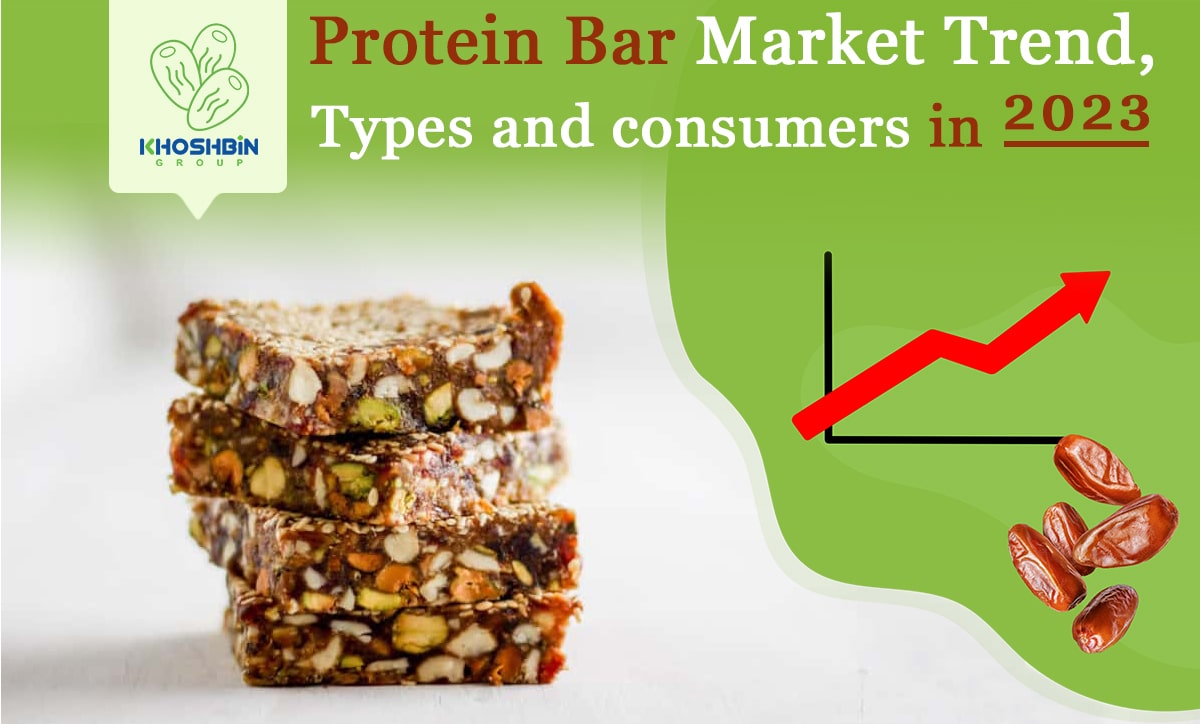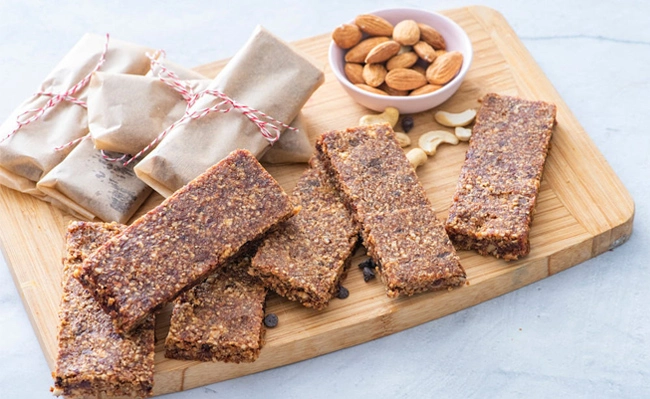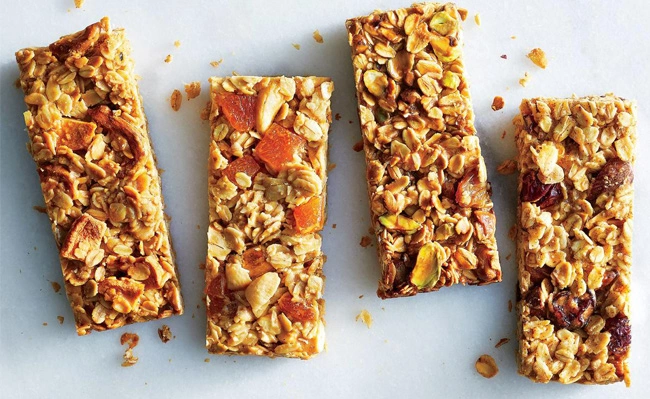Blog
Protein Bar Market Trend, Types and consumers in 2023

Protein bars is a general name given to a group of “snacks.” They are a quick way to get protein and other nutrients in a busy lifestyle. Protein bars are made from dates, dried fruits, nuts, seeds, and whole grains like oats and quinoa. In this article we discuss the protein bar market as well as the role dates can play in protein bars. More specifically, we introduce date paste binding ability in these food snacks alongside its other roles such as providing carbs, fiber, minerals and natural sweeteners.
What Is A Protein Bar?
Protein bar is a type of popular snack food designed to be a convenient source of healthy ingredients that does not require preparation. The primary purpose of a bar is to get a well-crafted amount of nutrients (carb, fat or protein) while still tasting great. The definition also includes plant-based protein bars, date-based protein bars, vegan protein bars, non-dairy protein bars, gluten-free protein bars, plant-oriented snack bars. The newest development in bar manufacturing is shifting toward healthier bases or binders as well as guil-free formulations.
The name “protein bar” is so popular that there is actually a protein bar market. This has tempted the introduction of non-protein snacks which may also be called by this name. These so-called protein bars contain high amounts of unhealthy sweeteners such as sugar or fructose corn syrup. So, it is important to always examine the ingredients on the label before making the purchase. And ideally by from trusted sources.
What Are Protein Bars Made Of?
A protein bar is a composition of several nutrient sources held together using binding agents. It contains varying amounts of protein, carbs, and fat. And it is often supplemented by vitamins, minerals, fiber and chocolate. There are proprietary labels that may offer closer to 40 grams of protein per serving. The calorie count of protein bars varies from 150–400.
The sources of nutrients are different and may define the value and price of bars. For example, the source of protein in high-quality bars may be yogurt powder, milk, or dairy proteins like casein and whey. Others may feature egg whites or nuts and seeds as a primary protein source.The primary sources of carbs are sugar, milk powders, sugar alcohols, fiber with additional carbs from cocoa powder. Nuts, nut oils, palm kernel oil, and almond butter usually constitute the sources of fats. Fiber can be supplied by a variety of sources such as date paste, which is rapidly finding its place in date-based protein bar formulations.
What Are Different Types Of Protein Bars?
There are many types of protein bars on the market. Some of these are not by definition even protein bars. They contain little to no protein, providing only unhealthy carbs. They are no better than eating a couple of biscuits. Considering these and other types, the protein bar market includes the following offerings.
Protein bars
Protein bars are snacks full of protein. These are low in carbs and high in protein. A typical protein bar has between 8 to 40 grams of protein and 150-300 calories. The main purpose of a protein bar is to provide proteins necessary for the development of body muscles. Nuts, seeds, and grains are usually used as sources of protein.

Pic: weelicious.com
There are three general kinds of protein bars to fill different purposes. These include;
- Low protein (0-15 grams) bars
- Medium protein (16-25 grams) bars
- High protein (above 25 grams) bars
Energy bars
Energy bars are another type of wrapped foods marketed as a way to provide “energy” to the body. Energy bars contain a lot of sugar, and are popular among people who are working hard or exercising. For example, they provide energy and nutrition before and after running or other heavy sports. Peanut butter energy bars contain a lot of sugar, giving the person eating them a burst of energy. However, some energy bars are supplemented with extra protein to deliver the protein bar’s functions. In general, energy bars have less calories than candy bars.
Candy bars
Candy bars are long, thin, sweet convenience foods inside plastic wrappers. Typically, they are covered in chocolate and have very little protein and high sugar. Candy bars are considered high calorie foods as they contain larger portions of carbs. They are often sold in convenience stores and gas stations as snacks.

Pic: naturaldelights.com
Candy bars and energy bars are used interchangeably. They both have little nutritional value because of the high calorie count and low nutrition value. They are both rich in carbohydrates. So, they are bad options for weight loss goals. They are also poor meal replacements.
Meal replacement bars
Meal replacement bars also include a protein source and are intended to replace various nutrients in a meal. Meal replacement bars can be consumed as part of a healthy balanced diet. They can also be eaten as a healthy alternative to a tasty treat on the go or to replace a meal when you’re trying to follow a calorie-controlled diet.
Snack Bars (Flapjacks, Granola Bars, Cereal Bars)

Snack Bars (Flapjacks, Granola Bars, Cereal Bars) are by definition nutrition bars with varying protein, fat and carbs amounts coming from different sources. They may also use different binding agents such as date paste, date syrup, honey and chocolate. Some snack bars are loaded with so much sugar and carbs, rendering them unhealthy. However, there are others with well-designed balanced nuts, seeds, grains and fruits.
Date wholesome protein bars
Date wholesome protein bars are nutrition bars based on date products, mostly date paste. The reason we opened a new category for date protein bars is date features. It is not only sweet, or high in fiber or antioxidants or sticky. It is a combination of all. When you apply its sweetness to foods, you inextricably enjoy its fiber and antioxidants or have to deal with its tacky texture. Also, it is filling, keeping you full for longer periods, which is the main purpose for eating protein bars in the first place. Of course, there are other date paste nutritional and health benefits that make it an excellent ingredient for bars. They offer a way forward to improve the value of nutrition bars by substituting sugar.
Are Protein Bars Junk?
Protein bars are considered super healthy due to their nutritional composition. They help keep you going when you’re on the run. Those containing a higher percentage of whole grains, nuts, seeds and fruit offer more nutrients and fiber. So, they provide more energy and better health. However, some so-called protein bars provide little nutritional value. They may even be unhealthy due to their high sugar content. However, there is a way to replace the artificial sugar in junk bars with something healthy such as date pate. Not only do you enrich its health benefits, you also make it more chewable and great tasting. There are various date paste recipes that show how to work with this wholesome food.
How Big Is The Protein Bar Market?
The protein bar global market is valued at 4.55 billion USD in 2021. It is predicted to grow at a compound annual growth rate (CAGR) of 6.2% to reach around USD 5.5 Billion by 2028. The main driver of the worldwide protein bar market is the growing consumers’ awareness of their health. This sole factor will boost the total sales and profits of the protein bars category.
What Are The Protein Bar Trends?
The market demand for the collective category of protein bars will continue to grow. However, the demand for plant-based ones is mounting. Key considerations are summarized here.

- The consumption of convenience foods such as snacks and protein bars has grown since the pandemic as more people started to work from home. Nutrition bars are gaining popularity for other good reasons. Nowadays, more individuals participate in recreational sports and fitness and athletic activities. They need protein bars to supply necessary nutrients, including proteins. Protein bars also boost energy levels and help with muscle growth.
- The popularity of protein bars will also increase as more people desire natural, plant-based ingredients. Specialized diets like vegan, gluten-free, and lactose-free are more prevalent in recent years. They also affect the market as they will increase the demand for plant-based snacks, such as date protein bars.
- Gluten-free and organic bar varieties help diversify market offerings. There has also been a rising trend of giving bar boxes as unique gift items. So, manufacturers and suppliers of these goods can concentrate on creative labels and wrappers to enhance their products’ market outlook and sales.
- The growth in the protein bar market offers unique benefit potentials for participants. So, the number of online and offline outlets and retail stores offering these goods will rise. These may include convenience stores, hypermarkets, and supermarkets. This increases the availability of snack bars through various payment ways or even doorstep delivery.
What Is The Target Market For Protein Bars?
The major consumers of protein bars include sports athletes and bodybuilders. Sports protein bars are meant to support muscle growth and maintenance. Other consumers include those who want to have wholesome snacks. These include students, travelers and people on a weight management program. Office workers may also enjoy a brunch of protein bars. Protein bars can also supplement the nutritional requirements of growing children.
Are protein bars profitable?
Yes, though it is hard to calculate a profit margin representative of all markets around the world. Price continuous consumers always try to drive the prices down, while less sensitive consumers value nutrition over cost. In general, the gross margins for a stick of protein bar is typically around 45%. This allows the producer/seller to manage costs easily
Conclusion
The protein bar market especially for plant-based types is predicted to show a steady growth in the next few years. The market is still young and offers huge opportunities for investment and market development. So, it will attract more participants and investments. Date paste can enhance the nutritional value of bars. It is used as a sugar substitute, nutrition source and binding agent in candy, energy, meal replacement and protein bars.
Do you manufacture protein bars? How does the market affect your business? Please tell us about it.
FAQ
Hi there, we a swimming club in Port Elizabeth and would like a representative to market ur products and it’s benefits at our club.